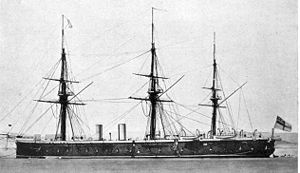HMS Achilles (1863)
 Achilles, 1867–1877
| |
| History | |
|---|---|
| Name | Achilles |
| Namesake | Achilles |
| Ordered | 10 April 1861 |
| Builder | Chatham Dockyard, England |
| Cost | £469,572 |
| Laid down | 1 August 1861 |
| Launched | 23 December 1863 |
| Completed | 26 November 1864 |
| Renamed |
|
| Fate | Sold for scrap, 26 January 1923 |
| General characteristics | |
| Type | Armoured frigate |
| Displacement | 9,820 long tons (9,980 t) |
| Length | 380 ft (115.8 m) |
| Beam | 58 ft 3 in (17.8 m) |
| Draught | 27 ft 2 in (8.3 m) |
| Installed power |
|
| Propulsion | 1 shaft, 1 trunk steam engine |
| Sail plan | Ship rig |
| Speed | 14 knots (26 km/h; 16 mph) |
| Range | 1,800 nmi (3,300 km; 2,100 mi) at 6.5 knots (12.0 km/h; 7.5 mph) |
| Complement | 709 |
| Armament |
|
| Armour | |
HMS Achilles was an
Achilles was recommissioned in 1901 as a depot ship at Malta under a succession of different names. She was transferred to Chatham in 1914 and was again renamed multiple times before she was sold for scrap in 1923. Achilles had more changes of her rigging and armament than any other British warship, before or since.[3]
Design and description
Achilles was the third member of the 1861 Naval Programme and was designed as an improved version of the earlier Warrior-class armoured frigates with a complete waterline armour belt.[3]
The ship was 380 feet 2 inches (115.9 m)
Propulsion
The ship had a single two-cylinder
As built, Achilles was
Armament
The intended armament of Achilles changed no less than five times before it was finally mounted. She received four rifled
Detailed data for the Somerset cannon is not available, but the 7.9-inch (201 mm)
Achilles was rearmed during her 1867–68 refit with 22 seven-inch and eight 8-inch (203 mm)
In 1874 the ship was rearmed with 16
Armour
The ship had a wrought-iron waterline armour belt that ran the full length of the ship.
Construction and career
Achilles, named after the Greek mythological

She served in the
She lay derelict in the
The Achilles in Literature
Charles Dickens offered a short meditation on the construction of HMS Achilles following a visit to Chatham Dockyard in 1863, first published in the weekly magazine All the Year Round on 29 August 1863, and then included in his collection The Uncommercial Traveller. Dickens came away impressed by the experience, and the idea that such a large iron construction could float or move. "To think that this Achilles, monstrous compound of iron tank and oaken chest, can ever swim or roll! To think that any force of wind and wave could ever break her!" [24]
Notes
- ^ Ironclad is the all-encompassing term for armoured warships of this period. Armoured frigates were basically designed for the same role as traditional wooden frigates, but this later changed as the size and expense of these ships forced them to be used in the line of battle.
Footnotes
- ^ a b c d Chesneau & Kolesnik, p. 9
- ^ Brassey, p. 230
- ^ a b c d Parkes, p. 40
- ^ a b Ballard, p. 241
- ^ Parkes, p. 39
- ^ Parkes, pp. 40, 43
- ^ Ballard, p. 246
- ^ Ballard, pp. 246–47
- ^ a b Parkes, p. 42
- ^ Ballard, pp. 43–44
- ^ Parkes, pp. 39, 41
- ^ Lambert, pp. 86–87, 89
- ^ Ballard, p. 43
- ^ a b Chesneau & Kolesnik, p. 6
- ^ Parkes, pp. 39, 42
- ^ a b Silverstone, p. 207
- ^ Ballard, p. 240
- ^ Parkes, pp. 39–40
- ^ Ballard, pp. 46–47, 236–237
- ^ "(untitled)". Morning Post. No. 33471. London. 6 October 1879.
- ^ Parkes, p. 43
- ^ Fort St Angelo, in the Lonely Planet Guide for Malta and Gozo.
- ^ Ballard, p. 47
- ^ Dickens, Charles (1905). The Uncommercial Traveler. Chapman & Hall LD.
References
- ISBN 0-87021-924-3.
- Chesneau, Roger & Kolesnik, Eugene M., eds. (1979). Conway's All the World's Fighting Ships 1860–1905. Greenwich, UK: Conway Maritime Press. ISBN 0-8317-0302-4.
- Jones, Colin (1996). "Entente Cordiale, 1865". In McLean, David & ISBN 0-85177-685-X.
- Lambert, Andrew (1987). Warrior: Restoring the World's First Ironclad. London: Conway. ISBN 0-85177-411-3.
- Parkes, Oscar (1990). British Battleships (reprint of the 1957 ed.). Annapolis, Maryland: Naval Institute Press. ISBN 1-55750-075-4.
- Silverstone, Paul H. (1984). Directory of the World's Capital Ships. New York: Hippocrene Books. ISBN 0-88254-979-0.
- Brassey, T.A., ed. (1890). The Naval Annual 1890. Portsmouth: J. Griffin and Co.
